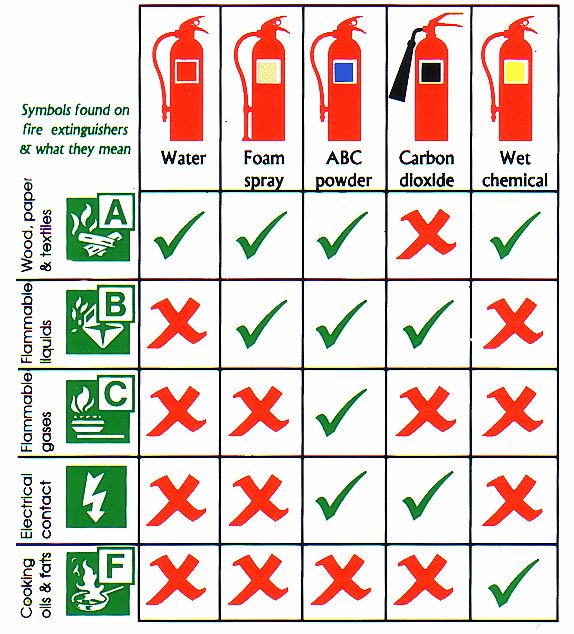class b fire is caused by
As such class B fires require a different approach from class A fires to combat. Fire Classes - Fsh Direct.

Different Types Of Fire Extinguishers Used On Ships
Class b fires are fires which involve flammable or combustible liquids.

. Class b fire is caused by. There are four classes of fires. Combustible liquids and gases - The word combustible simply means to ignite or burn and the opposite of it is non-combustible.
A carbon dioxide fire extinguisher works on a Class B fire by expelling CO2 to suffocate the fire removing the oxygen necessary to keep it burning. Because ordinary combustibles are so common in house fires authorities usually recommend that you get a fire extinguisher that includes at least an AB rating Most common fire extinguishers are class ABC. Class B fire refers to a fire involving flammable liquids such as petroleum gasoline kerosene petrol diesel octane etc paint alcohol solvent oil and tar etc.
These materials are typically found in. Class B fires are determined by. The use of lighter fluid on a charcoal grill for example creates a Class B fire.
Examples o include fats alcohol oils petroleum etc. In order to have a fire you need fuel oxygen heat and a chemical reaction. Flammable Liquids and Gases.
Electrical equipment appliances and wiring in which the use or a nonconductive extinguishing agent prevents injury. In fire classes a Class B fire is a fire in flammable liquids or flammable gases petroleum greases tars oils oil-based paints solvents lacquers or alcohols. Class B Fire It is common for a class B fire to occur within a work environment such as a mechanics workshop or petrol station some common examples of ignition include discarded cigarette butts or sparks from machinery that.
It should be extinguished by either fire blanket or sand if it is small if it is large a dry powder foam or carbon dioxide should. Ordinary solid combustibles such as paper wood cloth and some plastics. Class B fires involve flammable liquids and gases especially fuels like petroleum or petroleum-based products such as gasoline paint and kerosene.
Most of these liquids have a high carbon content and the compounds in them and are highly combustible. The us system includes flammable gases in their class b. The fuel for a Class B is a combustible gas or liquid.
In the United States all flammable liquids and gases are Class B. All these substances are. B Fire caused by petrol is fire class B.
There are a variety of fire extinguisher types designed to accomplish this very task specifically on Class B fires. That normally do not leave any embers or residues or very low amounts of residues. Other gases that are highly flammable are propane and butane which are common causes of Class B fires.
Class B fires are caused by flammable andor combustible liquids such as chemical-based cleaning products petrol oils and alcohol. The majority of businesses in Houston do avail a private state-of-art facility where they conduct all their works and provide services. It should be extinguished by water.
Some plastics are also Class B fire materials. The only difference is the fuel. But you may find a situation where your office or home materials get attacked by Class B Type Fire.
These fires are most commonly kitchen fires as they involve cooking oils. It also helps with removing the heat as the discharge is very cold. A Class B fire is fire that is caused by liquid and materials that are capable of melting through the application of heat energy onto them.
You should use class c fire extinguishers or one classed for abc or bc fires to put out an electrical fire. Immediately fire should be put off by using appropriate extinguishers as follows- a Fire caused by clothes is a fire class A. If you have a metal fire the best way to put this out is to use a dry powder extinguisher only.
Any of the following may be the fuel source for a Class B fire. For example propane natural gas gasoline and kerosene fires are types of Class B fires. Fires caused due to flammable liquid substances like petrol diesel oil varnish solvents paints kerosene cooking oil etc are classified as class B or type B fire.
Flammable liquids such as alcohol ether oil gasoline and grease which are best extinguished by smothering. Class B Type Fire in Houston TX. Class B fires occur for flammable and combustible liquids such as gasoline alcohol oil-based paints lacquers.
Any of the following may be the fuel source for a class b fire. Water or foam extinguishers will cause these kinds of fires to get worse so be on your guard. Cooking Oils andor Fats.

The Five Classes Of Fires And The Fire Extinguishers That Stop Them Strike First Usa

Different Types Of Fire Extinguishers Used On Ships

Types Of Fire Extinguishers A Guide Fire Risk Assessment Network

Different Types Of Fire Extinguishers Used On Ships

Which Fire Extinguisher Should I Use For Each Type Of Fire Infographicbee Com Types Of Fire Fire Extinguisher Training Extinguisher

The Abcs Ds And Ks Of Fire Extinguishers Occupational Health Safety

What Are The 5 Different Classes Of Fires Vanguard

Types Of Fire Extinguishers A Guide Fire Risk Assessment Network

The Types Of Fire Extinguishers Classifications Water Foam Co2

Find Out What The Symbols On Your Fire Extinguisher Actually Mean Foremost Promotions

The Different Types Of Fires Classes Prevention Reaction

Most Fire Extinguishers Used In The Hospital Are Class A B C 1 A Used On Wood Cloth Paper 2 B Us Extinguisher Fire Extinguisher Fire Extinguishers

Abcs Of Fire Extinguishers Fire Prevention Services The University Of Texas At Austin

Fire Extinguisher Types How To Choose The Right Class

Fire Extinguisher Types How To Choose The Right Class

The Types Of Fire Extinguishers Classifications Water Foam Co2


